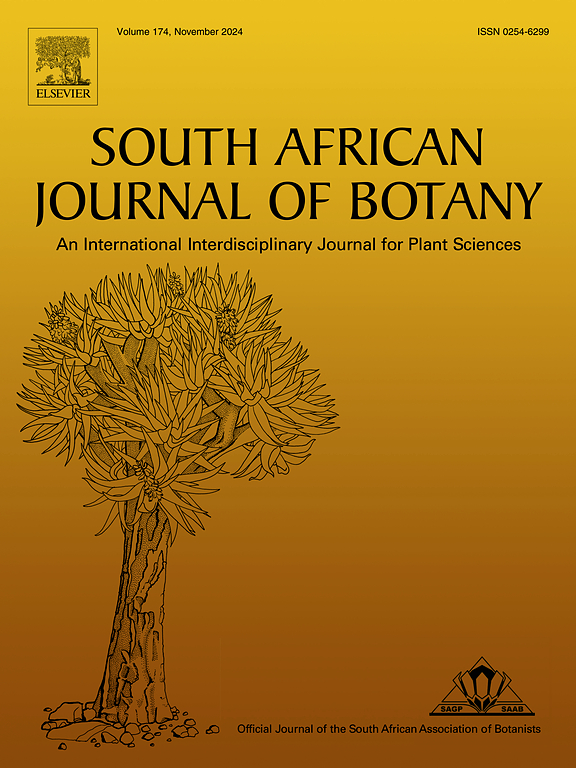Phenolic acids in some under-utilized medicinal and leafy vegetables, their anti-inflammatory and wound healing activities
IF 2.7
3区 生物学
Q2 PLANT SCIENCES
引用次数: 0
Abstract
The present study aimed to investigate anti-inflammatory and wound healing potentials of Launea taraxacifolia, Solanecio biafrae, Basella alba, Gnetum africanum, Solanum macrocarpon, and Crassocephalum rubens, which are traditionally used as food and ethnomedicinally for alleviating body pains, arthritis, wounds, and fever in Africa. Bioactivity assays were conducted using ethanol and water extracts, as well as partitioned fractions from crude ethanol extracts. In vitro anti-inflammatory activity was evaluated by inhibiting 15-lipoxygenase (LOX), xanthine oxidase (XO), and nitric oxide (NO) scavenging. In vivo assessments included the carrageenan-induced paw edema model, abdominal constriction test with p-benzoquinone, Freund’s Complete Adjuvant (FCA) pyrexia induction, and excision and incision wound models in mice to evaluate anti-inflammatory, antinociceptive, antipyretic, and wound healing activities, respectively. Additionally, HPLC fingerprinting and phenolic compound quantification were performed. Among the plants studied, Crassocephalum rubens and S. biafrae exhibited the most significant 15-LOX and XO inhibition, NO scavenging, in vivo anti-inflammatory, antinociceptive, antipyretic, and wound healing effects. HPLC analysis identified chlorogenic, caffeic, and p-coumaric acids, resveratrol, and rutin, which showed significant NO scavenging and XO inhibitory activities, suggesting these compounds may contribute to the anti-inflammatory effects of these plants. These findings support the ethnomedicinal use of C. rubens and S. biafrae for treating arthritis and wounds.
一些未被充分利用的药用蔬菜和叶菜中的酚酸及其抗炎和伤口愈合活性
摘要本研究旨在探讨非洲传统食物和民族医药学上用于缓解身体疼痛、关节炎、伤口和发烧的龙葵、牛膝草、非洲木犀草、大骨龙葵和大头草的抗炎和伤口愈合潜力。生物活性测定采用乙醇和水提取物,以及从粗乙醇提取物中分离的部分。通过抑制15-脂氧合酶(LOX)、黄嘌呤氧化酶(XO)和一氧化氮(NO)清除来评估其体外抗炎活性。体内评估包括卡拉胶诱导小鼠足跖水肿模型、对苯醌腹腔收缩试验、弗氏完全佐剂(FCA)热诱导以及切除和切口伤口模型,分别评估其抗炎、抗炎、解热和伤口愈合活性。HPLC指纹图谱和酚类化合物定量分析。在所研究的植物中,红草(Crassocephalum rubbens)和白草(S. biafrae)表现出最显著的15-LOX和XO抑制作用、NO清除作用、体内抗炎、抗伤、解热和伤口愈合作用。HPLC分析发现,绿原酸、咖啡酸、对香豆酸、白藜芦醇和芦丁具有明显的NO清除和XO抑制活性,表明这些化合物可能与这些植物的抗炎作用有关。这些发现支持了C. rubens和S. biafrae用于治疗关节炎和伤口的民族医学用途。
本文章由计算机程序翻译,如有差异,请以英文原文为准。
求助全文
约1分钟内获得全文
求助全文
来源期刊

South African Journal of Botany
生物-植物科学
CiteScore
5.20
自引率
9.70%
发文量
709
审稿时长
61 days
期刊介绍:
The South African Journal of Botany publishes original papers that deal with the classification, biodiversity, morphology, physiology, molecular biology, ecology, biotechnology, ethnobotany and other botanically related aspects of species that are of importance to southern Africa. Manuscripts dealing with significant new findings on other species of the world and general botanical principles will also be considered and are encouraged.
 求助内容:
求助内容: 应助结果提醒方式:
应助结果提醒方式:


